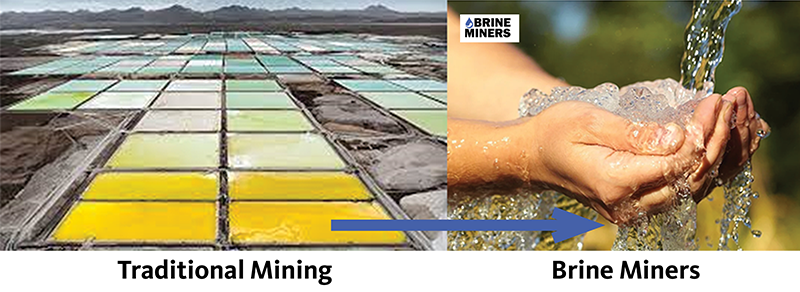Brine Miners transforms salty waste from water desalination, increasingly the only way some access fresh water, into a value-added resource. Desalination produces an intensely salty “brine” wastewater that negatively impacts marine ecosystems when it is dumped back into oceans. Our innovation reduces these environmental impacts and provides economic benefits, extracting valuable minerals and hydrogen and eliminating environmental and economic disposal costs.
Our innovative platform technology extracts critical minerals like lithium, magnesium, and green hydrogen from desalination wastewater. These have immense value as feedstocks for growth industries and are traditionally obtained via expensive and environmentally harmful processes. Mining these materials from brine waste offers a reliable and economically viable source that also eliminates an environmentally harmful waste stream, supporting US circular economy efforts to reduce waste, reuse critical materials, and protect the environment.
The Brine Miners team of researchers, entrepreneurs, environmentalists, and end-users see abundant saline waste brines as a valuable resource. The team’s technical and business capabilities combine existing processing technology with practical operational needs. The process’ only byproduct is clean water that can contribute to habitat restoration.
Existing desalination plants around the world take in about 86,000 million cubic meters (23 trillion gallons) of seawater annually and discharge a staggering amount of super-salty waste (brine) back into the ocean. This waste brine contains materials with an aggregate value of $2.2 trillion -- including 15.8 million kilograms of lithium, a crucial component of the rechargeable batteries that power electric vehicles. The Brine Miners technology platform seeks to tap into the untouched market value of waste brines while simultaneously producing clean water and green hydrogen. This could pave the way for expanding seawater desalination and turn a harmful waste stream into a sustainable supply of lithium and other critical materials.
Secondary user-inspired market data also show that the Brine Miner platform is suitable for other types of wastewater handling, such as those from semiconductor industries and oil/gas companies, offering a wide range of wastewater suppliers for whom Brine Miners can unlock millions of dollars in economic value.
Brine Miners integrates multiple award-winning, patented innovations into a single, versatile platform that not only extracts lithium and other valuable minerals from extremely salty brine waste but also generates clean water for industrial reuse or environmental rehabilitation. The team follows human-centered design principles in conjunction with a commitment to circular economy goals to develop their technology, remaining committed to using renewable energies and providing economically effective options for brine waste producers. The Brine Miners solution is a robust platform different from historic water mining approaches, relying on a creative combination of heat and physical barrier-based desalinations. Electrically charged physical membranes are used to initially treat incoming brine waste, followed by a novel Zero Liquid Discharge process powered by environmentally conscious heat sources. Through our partnership with SkyNano, an end-user that will use lithium carbonate produced by Brine Miners to capture and sequester carbon dioxide in the atmosphere, Brine Miners will move toward a near-term goal of net carbon-negative operations.

Our multidisciplinary team is comprised of 15 researchers from academia, industry, and government and is supported by a project managing team and advisory board. Oregon State leads the technology development with Espiku, Membrion, SkyNano, MemPro, De Nora, and Challenger Biosciences. Research on water-mineral separation, mining, and green hydrogen production will be applied and scaled to maximize life cycle and circular economy benefits.
Partnerships from end-users such as IDWT and Standard Lithium support pilot-scale prototypes. OSU’s Advanced Technology & Manufacturing Institute, a massive innovation ecosystem of labs, industry startups, and state-of-the-art spaces, further catalyzes the R&D activities.
Texas A&M leads the circular economy modeling and analysis, developing a systems-level tracking and quantification approach for economic value retention and environmental benefits.
There has already been, and there is expected to be more, intellectual property created during Phase II. The Brine Miners team is committed to openness and thus uses the least restrictive licensing to accommodate and encourage broad industry participation.